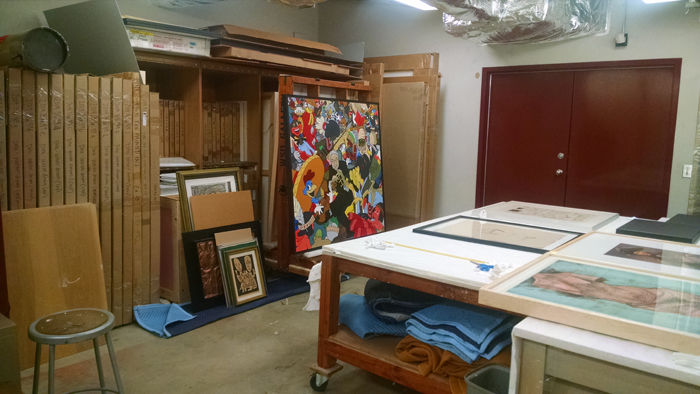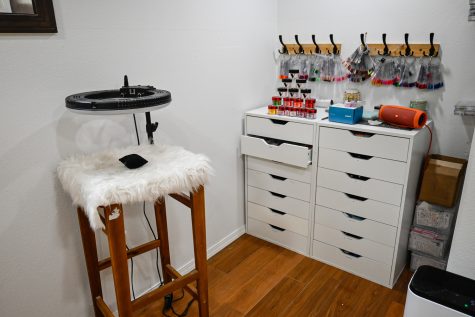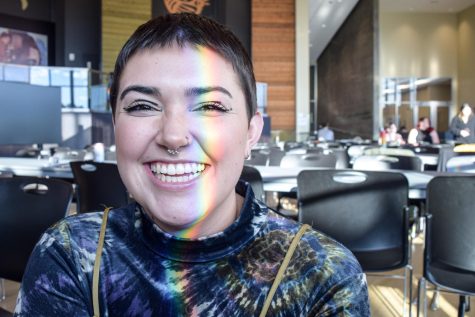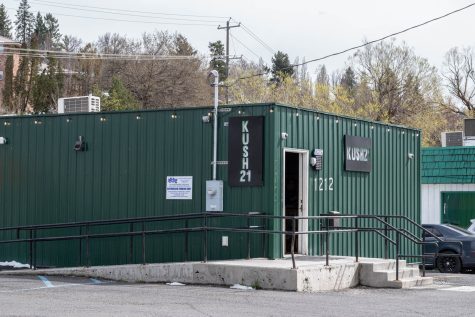“The vault:” Where art, history and teaching collide
The WSU Museum of Art Permanent Collection is located in “the vault,” a room under the current museum gallery. More than 3,000 pieces of art are stored in this space.
May 18, 2016
Down in the windowless vault of the Fine Arts building, 3,294 pieces of art rest, ready to serve as learning tools for students, ready to be brought into the spotlight of the gallery, or simply ready to show anyone who peers in through the door a timeless history of creation and culture.
Zach Mazur, curator of education and collections at the museum, said the WSU Museum of Art permanent collection dates back to the inception of the museum itself. When the museum was created, college faculty and staff donated art to be put on display and added to the permanent collection.
Anna-Maria Shannon, associate director of the Museum of Art said the Washington State College started the fine arts department in 1932. “While they were developing the (fine arts) program, they wanted to give students the opportunity to paint and draw.”
In 1932, a fine arts program was put in place to offer students painting and drawing classes. Classes in museum works and exhibit installation were added after, and the permanent collection is now used to teach students how to handle paintings, design exhibits and put up displays, Mazur said.
Art donated by then-president Ernest Holland, portrait painter Worth Griffin and past regent Charles Orton, made up the original collection, Shannon said.
The museum began to receive more art and recognition after World War II, and has only grown since, she said.
The permanent collection goes back about 250 years, and mostly includes work from the Northwest, Mazur said. The collection usually grows from donations from collectors in the area, or from the artists themselves gifting specific pieces. WSU has the largest collection of Jim Dine art, 206 pieces, of any college, he said. Jim Dine was the artist who created the blue “Technicolor Heart” located on the corner of Stadium Way and Grimes Way.
Mazur said that the museum typically receives pieces that are in “good” condition, but once in a while they will find a piece in need of repairs.
Mazur explained how the museum has collected a handful of pieces that are old and damaged, and restored them for the collection. One piece in the collection was left on a loading dock on campus. Mazur assumes a professor had it on display in their office and left it when they moved out.
The piece by George Inness was about 100 years old and in obvious disrepair. After having professionals examine the painting with black lights, they discovered the painting had been through fires and floods, that it had been patched up with tape, and touched up in areas with paint, Mazur said.
Mazur added that in general, the museum tries to avoid damaged paintings.
“We receive pieces that are perfect, but there are also pieces that are damaged,” he said. “We avoid pieces that are damaged, but sometimes you just have to take them because the work is so famous.”
The Museum of Art staff does basic repairs to the art, including reframing and condition repairs. Condition repairs include fixing tears or touching up damaged paint.
The fine arts department offers an internship class, where students learn how to do repairs and maintain the art, as well as how to install exhibits. The art in the permanent collection is sometimes put on display in the museum gallery, depending on the theme of the exhibit.
All of the art in the permanent collection has been on display at least once during the museum’s remodel.
For certain exhibits, the museum staff selects a theme and pulls art from the permanent collection, either to supplement a borrowed collection, or to make up the entirety of the exhibit, Mazur said.
The museum has only purchased one piece of art for the permanent collection, called “American vs. Disney Stereotype” by Roger Shimomura. This piece also happens to be Mazur’s favorite piece in the permanent collection.
“It’s a very easy painting to understand and navigate,” he said. “Let’s face it, visual images transcend languages and can be understood around the world.”
This piece depicts Shimomura in traditional Japanese clothing, crouching among dozens of Disney characters, from Jim Crow from the movie “Dumbo” and the Indians from “Peter Pan.”
Mazur stressed how important it is for students to take advantage of the permanent collection.
“It’s the single best way to teach students,” Mazur said. “They get hands-on work and experience.”
The permanent collection is not just a good resource for fine arts students, Mazur added. Although it is not very well-known on campus, the collection is a great way for students to take a look into the past and learn about art if that is an interest to them.
Now that the museum will be expanding to a new location, the museum staff plans to convert the current gallery into the new permanent collection storage space. Transporting the art from the current vault to the gallery will require careful handling, but the staff members expressed their excitement about the new location.
“We have over 3,000 objects in our permanent collection, some are very large that we’ll actually have to take outside and up the hill, and there are some delicate pieces,” said Ann Saberi, assistant curator at the museum. “Our current space is bursting at the seams.”
The new location will allow for better storage and better viewing of the collection for students and the public, said Ryan Hardesty, curator of art and exhibitions.
The museum staff is planning to have enough space in the new location for some of the collection to be on permanent display.





















